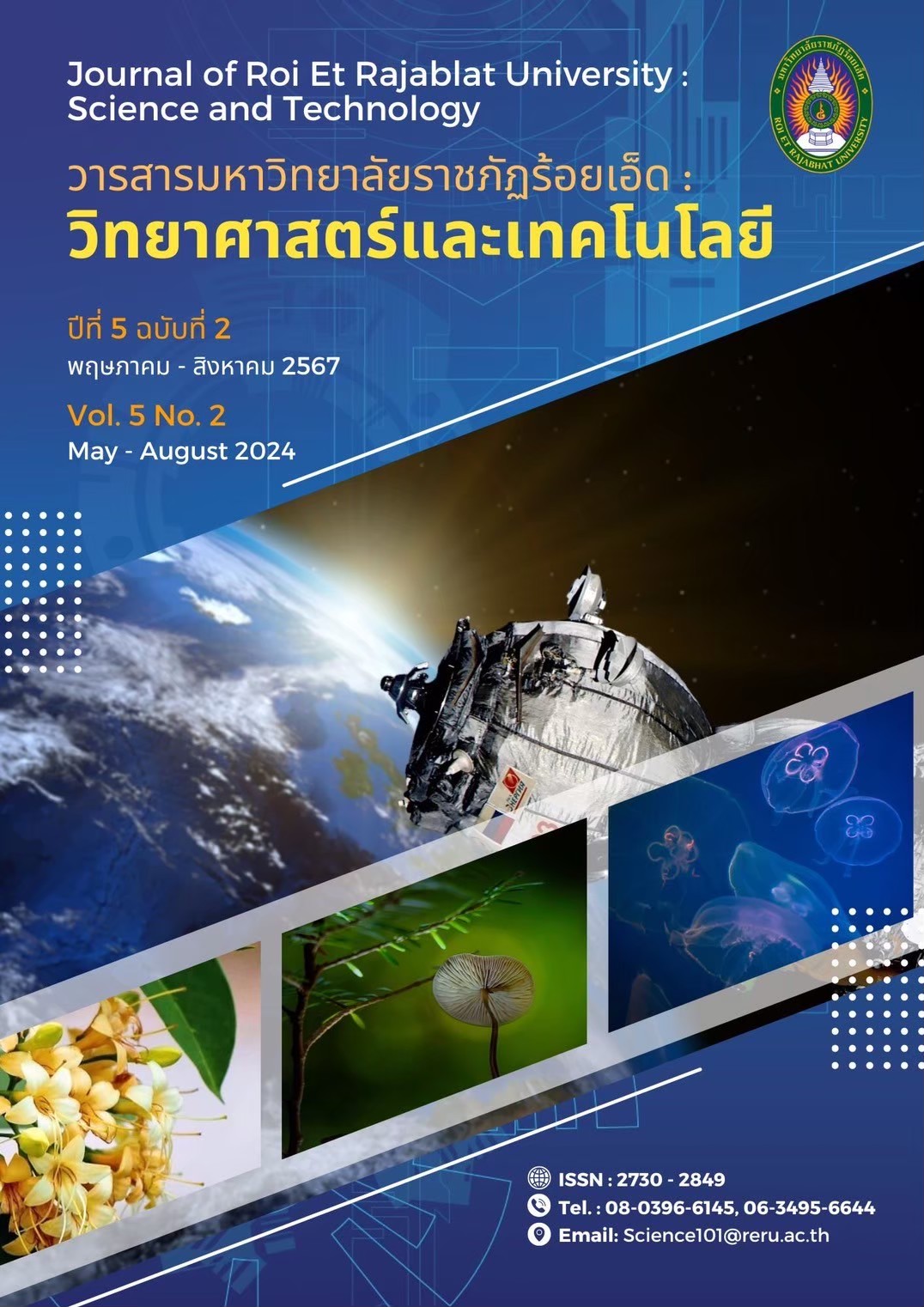การยับยั้งเชื้อสาเหตุโรคใบไหม้และส่งเสริมการเจริญเติบโตของข้าวต่างพันธุ์ด้วยแบคทีเรีย
บทคัดย่อ
การระบาดของศัตรูพืชเป็นปัญหาสำคัญในการผลิตข้าว โดยเฉพาะโรคใบไหม้สาเหตุจากเชื้อรา Pyricularia grisea (Sacc.) งานวิจัยนี้มีวัตถุประสงค์เพื่อคัดเลือกแบคทีเรียที่มีความสามารถในการยับยั้งการเจริญของเชื้อ P. grisea สาเหตุโรคไหม้ของข้าว และส่งเสริมความงอกและความแข็งแรงของต้นกล้าข้าว ซึ่งสามารถแยกแบคทีเรียได้ 196 ไอโซเลท จากส่วน ใบ ราก และดินบริเวณรอบราก แบ่งเป็น 10 กลุ่ม ตามลักษณะทางสัณฐานวิทยา นำมาทดสอบประสิทธิภาพการยับยั้งเชื้อรา P. grisea สายพันธุ์ JM01 ด้วยวิธี Dual culture วางแผนการทดลองแบบสุ่มสมบูรณ์เทียบกับ mancozeb และน้ำนึ่งฆ่าเชื้อ พบว่า แบคทีเรียสายพันธุ์ JMTU02 มีประสิทธิภาพในการยับยั้งการเจริญของ P. grisea สายพันธุ์ JM01 ได้ดีที่สุดถึง 55.72% (p≤0.05) รวมทั้งมีประสิทธิภาพในการยับยั้งการเจริญของเชื้อที่ติดมากับเมล็ด อีกทั้งแบคทีเรียสายพันธุ์ JMTU02 มีประสิทธิภาพในการส่งเสริมความงอก ความสูงต้น ความยาวราก และน้ำหนักต้นของข้าวพันธุ์ กข 15, กข 85, ปทุมธานี 1 และแม่โจ้ 2 อยู่ระหว่าง 58-95%, 5.62-12.33 เซนติเมตร, 1.19-4.64 เซนติเมตร และน้ำหนักต้น 0.10-0.11 มิลลิกรัม ตามลำดับ (p≤0.05)
เอกสารอ้างอิง
Akaranuchat. P., Changtang. S., Thobunluepop, P., Vearsilp, S., & Thanapornpoonpong S. (2010). Effect of Essential Oils Coating on Seed-borne Fungi in Maize Seeds. Journal of Agriculture, 26(1), 85-92.
https://li01.tci-thaijo.org/index.php/joacmu/article/view/246224/168350
Athinuwat, D., Chuaboon, W., Buensantei, N., & Prathuangwong, S. (2014). Efficiency of new plant growth promoting rhizobacteria on corn diseases control. African Journal of Microbiology Research, 8(7), 710-717. https://doi.org/10.5897/AJMR2013.6118
Buachard, S., Phuangphee, P., & Jamsa, N. (2022). Efficiency of Dry Formulation Bacillus sp. Ks5 to Plant Growth Promotion and Biological Control of Xanthomonas oryzae pv. oryzae Caused Bacterial Leaf Blight Disease. YRU Journal of Science and Technology, 7(2), 63-71. https://li01.tci-thaijo.org/index.php/yru_jst/article/view/253810/174348
Chettanachit, D., Nilpanit, N., Aranyanat, P., Sirisanthana, W., Rattanakarn, W., Dhitikiattipong, R., Rojanahasadin, W., & Arayapan, T. (2007). Rice disease and prevention and elimination. The Agricultural Co-operative Federation of Thailand, LTD. https://newwebs2.ricethailand.go.th/webmain/rkb3/Eb_017.pdf
Chuaboon, W., & Prathuangwong S. (2008). Appropriate Management Practices, Frequency and Concentration of Beneficial Bacteria Co-operation onto Increasable Control Efficiency of Economic Diseases on Cauliflower Plant. Kasetsart university annual conference 56th (subject: plant), 572-580.
https://kukr.lib.ku.ac.th/kukr_es/BKN/search_detail/dowload_digital_file/10809/100597
Chuaboon, W., Kasem, S., & Prathuangwong S. (2007). Co-Efficacy of Beneficial Bacteria Combined with Natural Products for Growth Promoting and Induced Resistance Against Diseases of Cauliflower Farm Production. Kasetsart university annual conference 45th (subject: plant), 357-363.
https://kukr.lib.ku.ac.th/kukr_es/BKN_AGRI/search_detail/dowload_digital_file/10152/100098
Danhorn, T., & Faqua, C. (2007). Biofilm formation by plant-associate bacteria. ANNUAL REVIEW OF MICROBIOLOGY, 64, 401-422. https://doi.org/10.1146/annurev.micro.61.080706.093316
Dennis, P. G., Miller, A. J., & Hirsch, P. R. (2010). Are root exudates more important than other sources of rhizodeposits in structuring rhizosphere bacterial communities. FEMS Microbiology Ecology, 72(3), 313-327. https://doi.org/10.1111/j.1574-6941.2010.00860.x
Department of Agricultural Extension. (2021). Rice Blast Diease. http://www.ppsf.doae.go.th/wordpress/wp-content/uploads/2021/10/โรคไหม้ข้าว.pdf
Department of Agriculture. (2005). Rice. Dok-bia. http://lib.doa.go.th/multim/e-book/EB00263.pdf
Dethoup, T. (2018). Plant disease: Chemical control. Text and Journal Publication Company Limited. https://ebook.lib.ku.ac.th/ebook27/ebook/20210101/
Jaihom, N., & Parinthawong, N. (2014). Disease assessment and cluster analysis of rice blast fungus collected in Thailand. Kasetsart university annual conference 52nd (subject: plant), 71-78.
https://kukr.lib.ku.ac.th/kukr_es/rice/search_detail/dowload_digital_file/13510/89057
Jitsuwannarak, K., & Wongcharoen, A. (2016). Efficiency of endophytic fungi to control rice blast disease (Oryza sativa L.). J. Khon Kaen AGR, 44(1), 232-237.
https://ag2.kku.ac.th/kaj/PDF.cfm?filename=O038%20Pat12.pdf&id=2252&keeptrack=5
Jungkhun, N., Ham, J. H., Shrestha, B. K., & Groth, D. E. (2017). Biological Control of Rice Blast Fungus: A Study Caseat Louisiana State University, United State of America Thai Rice Research Journal, 8(2), 95-105.
http://thairiceresearchjournal.ricethailand.go.th/images/PDF/8_2_2560/08.pdf
Naureen, Z., Price, A. H., Hafeez F. Y., & Roberts, M. R. (2009). Identification of rice blast disease suppressing bacterial strains from the rhizosphere of rice grown in Pakistan. Crop protection, 28,1052-1060. https://doi.org/10.1016/j.cropro.2009.08.007
Norkaew, J., Khemmuk, W., McGovern, R. J., & To-anun C. (2021). Selection ofantagonistic bacteria against Fusarium fujikuroicausing bakanae disease of rice. J. Khon Kaen AGR, 49(1), 144-154. https://li01.tci-thaijo.org/index.php/agkasetkaj/article/view/249324/173721
Ou, S. H. (1985). Rice Disease (2nd ed.). Commonwealth Agricultural Bureaux international. https://books.google.co.th/books?id=-k3mewv9nMoC&lpg=PR1&dq=1985.%20Rice%20disease%20ou&lr&hl=th&pg=PP1#v=onepage&q=1985.%20Rice%20disease%20ou&f=false
Ribot, C., Hirsch J., Balzergue, S., Tharreau, D., Nottéghem J., Lebrun M., & Morel, J. (2008). Susceptibility of rice to the blast fungus, Magnaporthe grisea. Journal of Plant Physiology, 165(1), 114-124. https://doi.org/10.1016/j.jplph.2007.06.013
Somrith, A., Jiamchaisri, Y., Bhasabutra, T., & Seemaduea, S. (2010). Surveying, Collecting and Identification of Plant Pathogen Fusarium. Research and development results in 2010, 1762-1781. https://www.doa.go.th/research/attachment.php?aid=931
Suwan, N. (2012). Isolation and characterization of antagonistic bacteria to control postharvest disease of Karen chili [Master's degree thesis, Chiang Mai University]. http://archive.lib.cmu.ac.th/full/T/2555/patho41055ns_ch4.pdf
Taweechai, N. (2010). Plant diseases and biological management: Mechanisms for controlling plant diseases using microorganisms.
https://www.saranukromthai.or.th/sub/book/book.php?book=35&chap=4&page=t35-4-infodetail02.html
Ulloa-Ogaz, A. L., Munoz-Castellanos, L. N., & Nevarez-Moorillon, G. V. (2015). Biocontrol of phytopathogens: Antibiotic production as mechanism of control. A Battle Against Microbial Pathogens: Basic Science, Technological Advances and Educatipnal Programs, 1, 305-309.
ดาวน์โหลด
เผยแพร่แล้ว
รูปแบบการอ้างอิง
ฉบับ
ประเภทบทความ
สัญญาอนุญาต
ลิขสิทธิ์ (c) 2024 คณะศิลปศาสตร์และวิทยาศาสตร์ มหาวิทยาลัยราชภัฏร้อยเอ็ด

อนุญาตภายใต้เงื่อนไข Creative Commons Attribution-NonCommercial-NoDerivatives 4.0 International License.
บทความที่ได้รับการตีพิมพ์เป็นลิขสิทธิ์ของคณะศิลปศาสตร์และวิทยาศาสตร์ มหาวิทยาลัยราชภัฏร้อยเอ็ด
ข้อความที่ปรากฏในบทความแต่ละเรื่องในวารสารวิชาการเล่มนี้เป็นความคิดเห็นส่วนตัวของผู้เขียนแต่ละท่านไม่เกี่ยวข้องกับมหาวิทยาลัยราชภัฎร้อยเอ็ด และคณาจารย์ท่านอื่นๆในมหาวิทยาลัยฯ แต่อย่างใด ความรับผิดชอบองค์ประกอบทั้งหมดของบทความแต่ละเรื่องเป็นของผู้เขียนแต่ละท่าน หากมีความผิดพลาดใดๆ ผู้เขียนแต่ละท่านจะรับผิดชอบบทความของตนเองแต่ผู้เดียว






